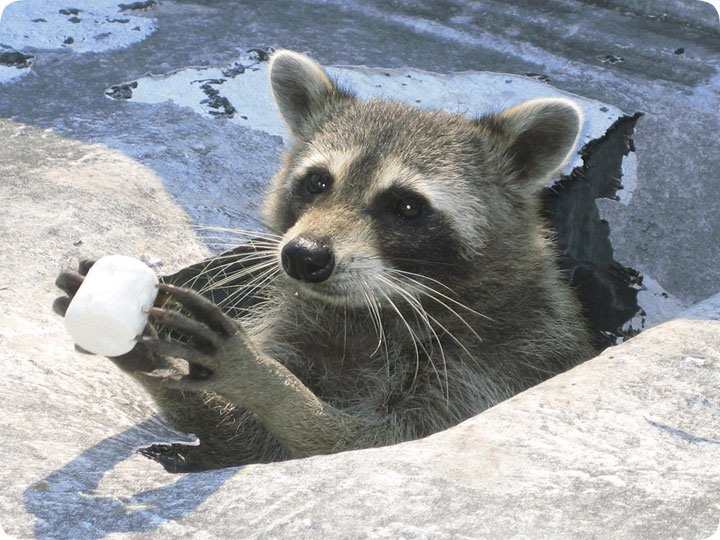-
info@aaanimalcontrol.com
Call us for help in your town
Humane Wildlife Education
Raccoon Bait - What Foods Catch Raccoons?

05.10.2006 - This blog entry is about what bait is best to trap and remove nuisance raccoons. If you are merely interested in feeding local raccoons, please, PLEASE do
not feed the wildlife. It is a lot of fun and it feels good to do, but it WILL result in animal suffering - critters dependent upon people, increased spread of disease,
unhealthy animals, and starvation when the food source is inconsistent or stops. If you want to know what food to feed a baby raccoon or pet raccoon, I don't advise
keeping them as pets, nor am I an expert in that matter.
Raccoons are omnivorous animals, which means that they feed on both plants and animals. Does this then imply that every food and plant can be used as a bait to trap raccoons, or do these mammals have preferences? Well, you are about to find out.
I'm often asked what bait I use to trap raccoons. If you want the quick and easy answer, it's
marshmallows. Now, if you want to not solve your raccoon problem, leave this page right now. If you do want to solve a raccoon problem, I should make it clear that
the type of bait used to trap raccoons is probably less than 1% of what goes into successful raccoon trapping.
Raccoons are omnivores. Thus, they eat pretty much
anything. A wide variety of baits will tickle their palates. Most of the wildlife trappers I know use a variety of foods, from wet or dry cat food, to white bread,
to special raccoon trapping pastes. However, in my years in the field, I've found that they love marshmallows. Raccoons love eggs, in fact, and I think they are
really drawn to the white color and shape. A colleague of mine caught raccoons with just white golf balls. And raccoons really have a sweet tooth, so marshmallows
are great. Plus they are easy to transport and store, and they are clean and easy to use.
However, like I said, the type of bait isn't really that important.
Type of trap, type of set, location, and a bunch of other factors are far more relevant. In addition, the mere trapping and removal of the animal is probably not what you
actually need to permanently solve the problem you are having with raccooons. In fact, I've seen far more cases of problems by amateur homeowners trapping and removing
raccoons than I've seen positives. Plus, trapping is illegal for non-licensed persons in most states.
Click here for RACCOON TRAPPING TIPS, a guide on how to trap raccoons with many advice points.
Click here for my HOW TO GET RID OF RACCOONS comprehensive guide on raccoon removal.
The raccoon (Procyon lotor), is a unique animal native to North America. It's not closely related to any other animals, with distant relatives such as bears and weasels. Coons are easy to recognize, with a black mask and ringed tail. Raccoons tend to weigh between 10-20 pounds
as adults. They are mostly nocturnal, and are omnivores. Racoons average a lifespan of about 5 years in the wild, and have a litter of 3-6 young each spring. They are very strong, excellent climbers, very intelligent, and they are very skilled with their hands. Raccoons have learned to
thrive in urban areas, and live in very high densities in cities, where they eat garbage and pet food. They commonly break into homes and attics, where they cause considerable damage, and they also destroy other property, and thus racoons are considered pest animals by many people. Raccoon
control and removal, especially from inside homes, is best left to a professional.
Get professional help: Visit my Nationwide Pro Directory of wildlife removal experts.
For more wildlife stories, click my Wildlife Blog
or click my below banner to hire a local trapper.
Taking a closer look at their eating habits, these nocturnal animals are not above feeding on human trash. When food is scarce, you'll find a female raccoon out in the daytime in search of food for her young, thereby defying their natural nighttime hunting instincts. It clearly shows that raccoons can go the extra mile for food.
That said, highlighted below is a list of irresistible foods that can lure raccoons into a live cage:
1. Marshmallows
This food always tops the list of foods that can successfully lure a raccoon. It is soft to chew and very appealing to raccoons. This wildlife is naturally attracted to the scent, size, and shape of marshmallows.
It has a high similarity to eggs, and it will keep the raccoon highly engaged inside the trap before it remembers it is trapped. Marshmallows are the best bait to use by far.
2. Eggs
It is no surprise that eggs are next on our list, as it seems raccoons are visually attracted to foods the size of an egg. Put the whole egg very close to the trigger, and you will have won the attention of the raccoon.
3. Meat and Fish
Raccoons are attracted to the delicious smell of these foods, and the stronger their scent, the more drawn raccoons are to them, which makes it another perfect bait.
4. Watermelon
This fruit is another effective bait for raccoons. Slice it into tiny bits, and you can use them to make a trail into the cage or simply arrange them behind the cage for a faster effect. Raccoons are attracted to the color and sweet taste of watermelon.
5. Strawberries
Slice strawberries into smaller pieces, then place them in and behind the live cage, and you can be sure that the raccoons will come crawling in for more.




















